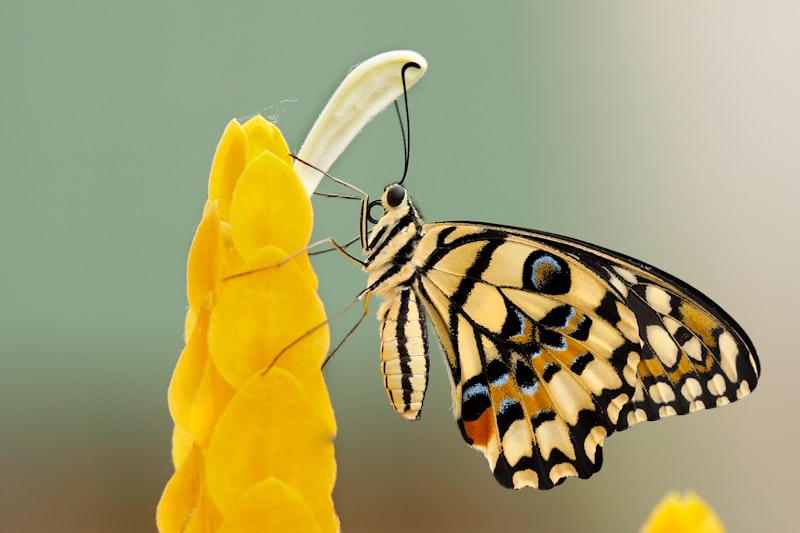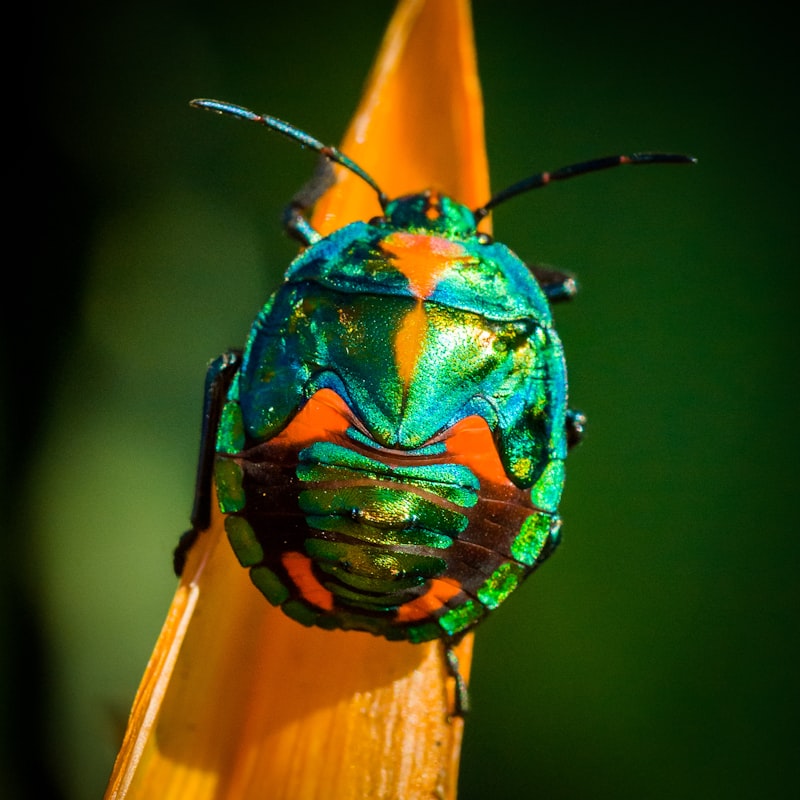Imagine being able to unravel the genetic codes of different insect species, like cracking open a treasure chest of biological secrets. Bioinformatics does just that by analyzing vast amounts of genetic data to understand how insects adapt to their surroundings, evolve over time, and interact with other organisms.

Insect ecology, on the other hand, studies the behavior, distribution, and abundance of insects in their ecosystems. It’s like piecing together a complex puzzle where each insect species plays a crucial role. Bioinformatics turbocharges this field by providing tools to study insect genomes, analyze their diets, track population dynamics, and even predict their responses to environmental changes.
One of the most fascinating aspects of bioinformatics in insect ecology is its role in conservation efforts. By studying the genetic diversity within insect populations, researchers can identify endangered species, track invasive ones, and develop strategies to protect biodiversity.
Moreover, bioinformatics helps in understanding how insects contribute to ecosystem services such as pollination, decomposition, and pest control. It’s like peeking behind the scenes of nature’s theater to see how these tiny actors keep the show running smoothly.
Unveiling Nature’s Algorithms: Bioinformatics Revolutionizes Insect Ecology

Insects, with their staggering diversity and ecological significance, have long intrigued scientists. From pollination to decomposition, these tiny creatures play crucial roles in ecosystem dynamics. However, studying them at a molecular level was once a daunting task. Enter bioinformatics—a field that merges biology with computational science to analyze biological data, including genomes, proteins, and metabolic pathways.
One of the most profound impacts of bioinformatics in insect ecology lies in genomic sequencing. By mapping out the entire genetic makeup of insect species, scientists can identify specific genes responsible for key traits like pesticide resistance or adaptation to climate change. This knowledge not only enhances our understanding of insect evolution but also aids in developing targeted strategies for pest management and conservation efforts.
Moreover, bioinformatics enables researchers to explore the intricate interactions between insects and their environments. Through computational models and big data analysis, scientists can simulate ecological scenarios, predicting how changes in habitat or climate might influence insect populations. Such predictive insights are invaluable for biodiversity conservation and agricultural sustainability.
Imagine bioinformatics as a powerful lens that magnifies the complexities of insect life. Like uncovering a hidden code, it allows us to decipher the molecular dialogues within insect communities. From the smallest genetic variations to large-scale ecological patterns, bioinformatics empowers us to grasp nature’s algorithms and harness them for both scientific discovery and practical applications.
As we delve deeper into the realms of bioinformatics and insect ecology, new frontiers await exploration. The synergy between biology and computational science continues to unveil the mysteries of nature, paving the way for innovative solutions to global challenges and fostering a deeper appreciation for the intricate web of life that insects weave.
From Bytes to Bugs: How Bioinformatics Transforms Insect Ecology Research
Insect ecology, the study of interactions among insects and their environment, benefits greatly from bioinformatics tools. Researchers can now analyze genetic sequences of insects to understand their evolutionary history, behavior patterns, and ecological roles. By mapping genomes, scientists can identify specific genes responsible for traits such as resistance to pesticides or adaptations to changing climates.
One of the key challenges in insect ecology research has been the sheer complexity and diversity of insect species. Bioinformatics helps in cataloging and comparing genomes across different insect species, providing insights into their taxonomy and phylogenetic relationships. This allows researchers to classify insects more accurately and understand their ecological niches better.
Moreover, bioinformatics aids in predicting how insect populations might respond to environmental changes or human interventions. By studying gene expression patterns and metabolic pathways, scientists can anticipate the ecological impact of invasive species or the spread of insect-borne diseases.
The transformative power of bioinformatics lies in its ability to process large-scale data sets efficiently. Algorithms and computational models sift through terabytes of genetic information, extracting meaningful patterns and correlations. This data-driven approach not only accelerates research but also fosters collaborations across disciplines, from genetics to ecology and beyond.
Bioinformatics is reshaping insect ecology research by offering new tools to explore the intricate relationships between insects and their environments. As technology advances and datasets grow, the field holds promise for discovering novel insights that could inform conservation efforts, pest management strategies, and our understanding of biodiversity in a rapidly changing world.
Decoding Nature’s Buzz: The Role of Bioinformatics in Insect Behavior Studies
Bioinformatics isn’t just about decoding genomes or studying diseases; it’s also a powerful tool for understanding animal behavior, including that of insects. Imagine if you could peek into the intricate social networks of ants, where each worker bee seems to know its exact role without any formal training. This is where bioinformatics shines bright.
At its core, bioinformatics merges biology with computer science to analyze biological data. In the case of insect behavior, researchers collect vast amounts of data on movements, interactions, and genetic markers from different species. These data points are then fed into sophisticated computer algorithms that crunch the numbers and reveal patterns that might otherwise go unnoticed.
Take the example of a honeybee hive. Each bee has a specific job, from nursing larvae to foraging for nectar. Bioinformatics helps scientists track individual bees’ activities over time, mapping out how tasks are assigned and how the hive as a whole functions as a superorganism. It’s like watching a symphony where every note and movement is meticulously orchestrated.
But why does this matter? Understanding insect behavior isn’t just about satisfying curiosity. It has practical implications, from improving crop pollination to managing pest control more effectively. By deciphering the rules governing insect societies, researchers can develop smarter strategies that benefit both nature and human agriculture.
Moreover, bioinformatics isn’t confined to the lab. Citizen science projects like tracking bumblebee populations or studying butterfly migrations rely on volunteers to collect data, which is then analyzed using bioinformatics tools. It’s a collaborative effort where everyone, from professional scientists to enthusiastic amateurs, plays a crucial role in expanding our knowledge.
So, the next time you see ants marching in perfect linearity or hear the gentle buzz of bees in a field of flowers, remember that behind these everyday scenes lies a world of complex data and insightful analysis. Bioinformatics isn’t just a tool; it’s a gateway to decoding nature’s buzz, one algorithm at a time.
Big Data, Tiny World: Bioinformatics Redefines Insect Population Dynamics
Imagine this: a world where every flutter of a butterfly’s wings or buzz of a mosquito’s flight leaves a digital footprint. That’s the power of Big Data in bioinformatics. By analyzing vast amounts of genetic information from insect populations, scientists can uncover patterns that were once hidden in the chaos of nature.
Bioinformatics isn’t just about collecting data; it’s about making sense of it. Researchers use sophisticated algorithms to crunch numbers and detect trends in insect populations. They can track changes in species distribution, identify genetic mutations that affect population growth, and even predict how environmental changes might impact insect communities.
Take the example of malaria-carrying mosquitoes. Through bioinformatics, scientists can pinpoint specific genetic markers that make certain mosquitoes more resistant to insecticides. This knowledge helps in developing targeted strategies for pest control, potentially saving millions of lives.
But bioinformatics isn’t limited to disease control. It also plays a crucial role in agriculture. By understanding the genetic diversity within insect populations, researchers can develop crop protection methods that are both effective and environmentally friendly. This means fewer chemicals in our food and healthier ecosystems for future generations.
In essence, bioinformatics is like having a microscope that magnifies the genetic makeup of insects. It reveals details that were once invisible to the naked eye, allowing scientists to unravel the complex web of interactions that governs insect populations. And as technology advances, so too will our ability to harness Big Data for the benefit of both humans and the tiny creatures that share our world.
Frequently Asked Questions
How can bioinformatics predict insect behavior and population dynamics?
Learn how bioinformatics utilizes genetic and environmental data to forecast insect behavior and population trends efficiently.
How does bioinformatics help analyze insect genomes and populations?
Discover how bioinformatics aids in studying insect genomes and populations. Learn how computational tools analyze genetic data to uncover insights into insect biology, evolution, and ecological interactions.
What are the challenges and future directions of bioinformatics in insect ecology?
Discover the challenges and future directions of bioinformatics in insect ecology, highlighting key obstacles and upcoming research trends.
What is the role of bioinformatics in studying insect ecology?
Learn about the crucial role of bioinformatics in advancing the study of insect ecology, analyzing vast datasets to uncover patterns in insect behavior, genetics, and environmental interactions.
What are some common bioinformatics tools used in insect ecology research?
Explore common bioinformatics tools used in insect ecology research, including tools for DNA sequence analysis (e.g., BLAST, Geneious), ecological modeling (e.g., MaxEnt, SDMtoolbox), and population genetics (e.g., GenAlEx, STRUCTURE). These tools facilitate studying insect populations, biodiversity, and interactions with the environment.


